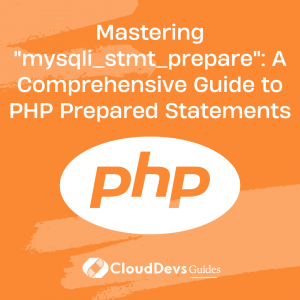Mastering “mysqli_stmt_prepare”: A Comprehensive Guide to PHP Prepared Statements
Table of Contents
If you are a PHP developer, you are most likely familiar with the MySQLi extension for handling database operations. One of its powerful features is the ability to create and execute prepared statements, which are precompiled SQL statements that can be executed multiple times with varying parameter values. Prepared statements offer a secure and efficient way to handle user input, reducing the risk of SQL injection attacks. In this tutorial, we will dive deep into the use of “mysqli_stmt_prepare” function, explaining its syntax, advantages, and demonstrating its use with examples.
Table of Contents
1. Understanding Prepared Statements
A prepared statement is a precompiled SQL query that allows you to separate the query structure from the actual data. Prepared statements use placeholders, usually represented by question marks (?) or parameter names, instead of directly including the data in the SQL query. When it’s time to execute the query, you bind the desired values to these placeholders, and the database will handle the rest.
2. Advantages of Prepared Statements
- Security: Prepared statements help prevent SQL injection attacks by separating the query structure from the data, making it harder for an attacker to inject malicious SQL code.
- Performance: Since the SQL query is precompiled, it can be reused multiple times with different data, reducing the time spent parsing and preparing the query.
- Code readability: By using placeholders, your SQL queries become more readable and easier to understand.
3. Syntax of mysqli_stmt_prepare
The mysqli_stmt_prepare function is used to create a prepared statement from a given SQL query. Its syntax is as follows:
bool mysqli_stmt_prepare ( mysqli_stmt $stmt, string $query )
Parameters:
- $stmt: A mysqli_stmt object representing the prepared statement.
- $query: A string representing the SQL query, with placeholders for the data.
Return value:
- The function returns TRUE on success or FALSE on failure.
4. Step-by-step Example: Using mysqli_stmt_prepare in PHP
Let’s create a simple example of using mysqli_stmt_prepare to insert data into a ‘users’ table.
<?php
$servername = "localhost";
$username = "your_username";
$password = "your_password";
$dbname = "your_database";
// Create connection
$conn = new mysqli($servername, $username, $password, $dbname);
// Check connection
if ($conn->connect_error) {
die("Connection failed: " . $conn->connect_error);
}
// Prepare and bind
$stmt = $conn->prepare("INSERT INTO users (firstname, lastname, email) VALUES (?, ?, ?)");
$stmt->bind_param("sss", $firstname, $lastname, $email);
// Set parameters and execute
$firstname = "John";
$lastname = "Doe";
$email = "john.doe@example.com";
$stmt->execute();
echo "New record created successfully";
$stmt->close();
$conn->close();
?>
5. Best Practices and Common Errors
- Always validate and sanitize user input before binding it to a prepared statement.
- Use the appropriate parameter type (e.g., ‘s’ for string, ‘i’ for integer) when binding parameters.
- Ensure that the number of placeholders in the SQL query matches the number of bound parameters.
- Close the prepared statement and the database connection when they are no longer needed.
6. Conclusion
The “mysqli_stmt_prepare” function is an essential tool in any PHP developer’s toolkit, offering a secure and efficient way to handle database operations.
7. Updating and deleting records
As we continue to explore the use of “mysqli_stmt_prepare” in PHP, let’s take a look at other common operations, such as updating and deleting records, as well as fetching data from a table using prepared statements.
7.1 Updating a record using prepared statements
The following example demonstrates how to update a user’s email address using a prepared statement:
<?php
// ... (connection setup)
// Prepare and bind
$stmt = $conn->prepare("UPDATE users SET email = ? WHERE id = ?");
$stmt->bind_param("si", $email, $id);
// Set parameters and execute
$email = "new.email@example.com";
$id = 1;
$stmt->execute();
echo "Record updated successfully";
$stmt->close();
$conn->close();
?>
7.2 Deleting a record using prepared statements
To delete a record using a prepared statement, you can use the following example:
<?php
// ... (connection setup)
// Prepare and bind
$stmt = $conn->prepare("DELETE FROM users WHERE id = ?");
$stmt->bind_param("i", $id);
// Set parameters and execute
$id = 1;
$stmt->execute();
echo "Record deleted successfully";
$stmt->close();
$conn->close();
?>
7.3 Fetching data using prepared statements
To fetch data from the database using prepared statements, follow the example below:
<?php
// ... (connection setup)
// Prepare and bind
$stmt = $conn->prepare("SELECT id, firstname, lastname, email FROM users WHERE email = ?");
$stmt->bind_param("s", $email);
// Set parameters and execute
$email = "john.doe@example.com";
$stmt->execute();
// Bind result variables
$stmt->bind_result($id, $firstname, $lastname, $email);
// Fetch the data
while ($stmt->fetch()) {
echo "ID: $id, Name: $firstname $lastname, Email: $email";
}
$stmt->close();
$conn->close();
?>
As you can see, using “mysqli_stmt_prepare” with prepared statements makes your PHP code more secure and efficient when working with databases. By following the examples and best practices outlined in this tutorial, you’ll be well-equipped to handle various database operations while minimizing the risk of SQL injection attacks.



